Long term planning does not always work out. Diana and Larry Brewer have long had Prague on their bucket list and the four of us scheduled a trip for July. Di took ill at the wrong time, and so she and Larry are working through trip cancellation insurance issues. The good news is that Di is on the road to recovery and the four of us plan to attend our fifth consecutive Telluride Film Festival over Labor Day Weekend. This assumes Rita’s ears un-pop by then (those long flights over the ocean).
Larry and Diana did not completely miss Prague. Larry provided life-size head-shots so they could take a virtual tour via our smartphones. This will explain many of the attached photos showing Flat Larry and Flat Diana. We were in Prague five nights and then cruised the Danube for a week. This was the flip side of a Danube cruise we did seven years ago with Larry and Di from Bucharest to Budapest.
Brief History: What is now the Czech Republic was for centuries part of various royal empires. Prague was a major center of arts and architecture and part of our prep for this trip was reading “The Magic Circle of Rudolf II” – the Hapsburg heir and Holy Roman Emperor who held court in Prague in the 16th century and was a renowned patron of the arts and sciences. Austria-Hungary joined the German side in WW1 and after the war was split into several countries, one being an independent Czechoslovakia. The new democracy was short-lived as Hitler annexed the country in 1938. The Nazis were knocked out by the “liberating” Soviets who forgot to leave. Attempts at reform in 1968 (the Prague Spring) were quashed by an invasion of tanks and troops. Czechoslovakia finally got the Soviets out in 1989 in the Velvet Revolution. In 1993, Slovakia separated to become a separate country (the Velvet Divorce) and the balance was renamed the Czech Republic.
Larry Charles Bridge: Actually, it is the Charles Bridge, but Larry’s middle name is Charles, leading Rita to dub it the Larry Charles Bridge.
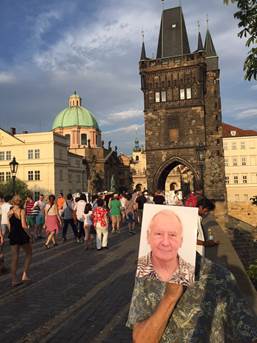
This medieval bridge over the Vltava River is lined with 30 baroque statues of saints. It leads in one direction to Old Town and the other to Prague Castle. The bridge today is pedestrian-only and jammed with street performers, artists, tourists and souvenir stands. Tourists can walk from the bridge to most sites, including up the steep steps to Prague Castle. Adjacent to one end of the bridge is the Klementinum, a former Jesuit college which is now the National Library. We climbed the 172 steps to the top of its observatory to give Larry and Diana a birds-eye view of Old Town and Prague Castle.
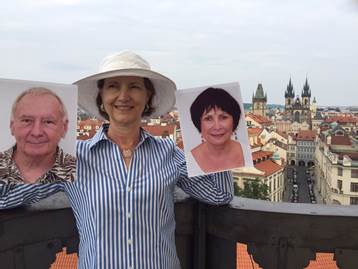
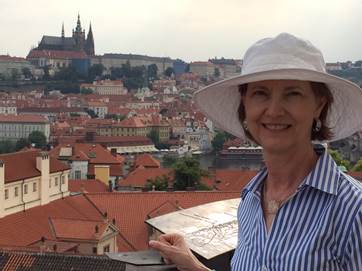
Prague Castle: This sprawling collection of palaces and courtyards is highlighted by the spires of St. Vitus Cathedral.
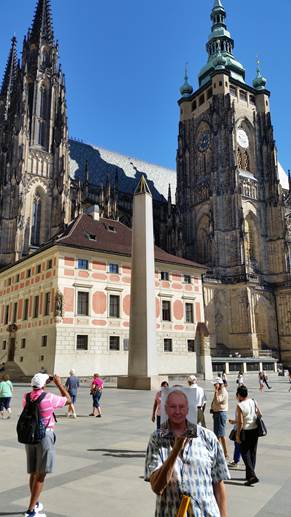
Most tourists limit their time to walking the courtyards and admiring the interior of the beautiful church, but there are shops and museums for those who want to linger. Our excellent Rick Steves’ guidebook led us to two nearby stops off the beaten path:
The Loreta Church draws pilgrims to see a wooden beam from Mary’s house in Nazareth. Tourists come to see the small church, bell tower and treasury. In a courtyard featuring saints, the one that catches your attention is the “St. Bearded Woman,” patron saint of unhappy marriages. Her family had arranged for a marriage she did not want, so she grew a beard and scared off the potential husband. Her father crucified her. There are many candles here from people suffering uncivil unions. We did not light one.
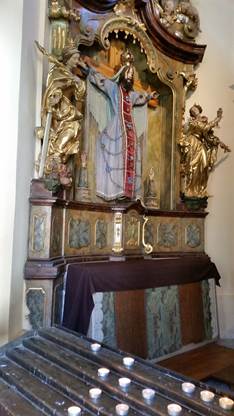
The Strahov Monastery and Library draws visitors to see two elaborately decorated libraries holding thousands of 10th to 17th-century books. There is an on-site brewery which provided the beer we had with lunch in an underground wine cellar. Just outside the monastery is a viewing terrace with superb views of Prague.
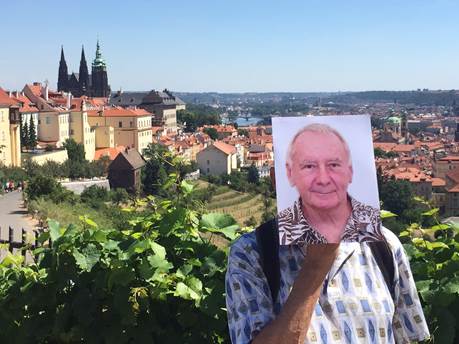
Lubkowicz Palace: As part of our prep for the trip, Rita and I read “City of Dark Magic,” a mystery novel by Magnus Flyte. It is loosely based on a line of Lubkowicz princes who occupied a palace in Prague Castle starting in the 16th century. In the true history, the family fled when the Nazis (and later the Communists) appropriated the palace, art and furnishings. After the Velvet Revolution, the current heir/prince William Lubkowicz left his Boston real estate business to pursue his claim for restitution of the only privately owned building at Prague Castle. He won and has converted the palace to a fine museum that we toured with an audio-guide expertly narrated by the prince. It is filled with fine art, arms and music exhibits acquired by the line of princes, many of whom were major patrons of the arts. The most unique to us was the music room where you can view symphony musical scores and manuscripts with handwritten notes by the likes of Mozart and Beethoven. One original score is for Beethoven’s Fifth which is dedicated to his patron, the 7th prince . The audio-guide plays that famous music as you view the exhibit.
Old Town: One of the key features of Prague is its exquisite medieval architecture in the historic district – and, very importantly, it did not suffer war damage like most European cities. This was the silver lining in the cloud of the 1938 Munich Agreement when Britain and France permitted the Nazis to absorb much of Czechoslovakia without firing a shot. The focal point is Old Town Square with its Gothic, Baroque and Rococo buildings. The anchors are the twin-towered Tyn Church and the Old Town Hall with its Astronomical Clock.
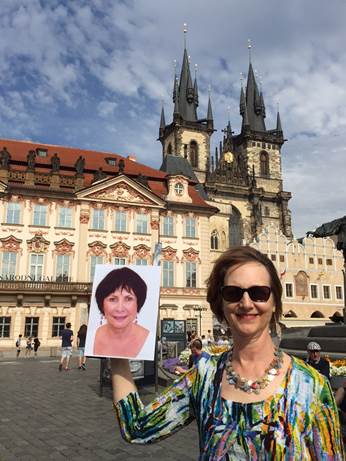
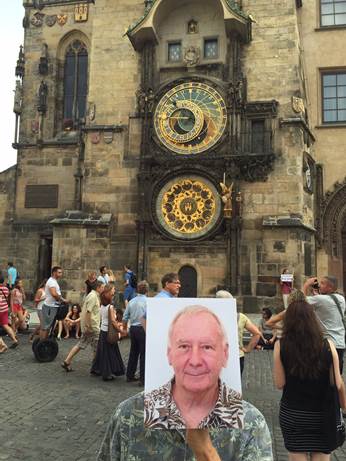
But the real draw for us was the lively mix of musicians, street performers and thousands of tourists. We consider it to be the best central city gathering place we have seen in our travels.
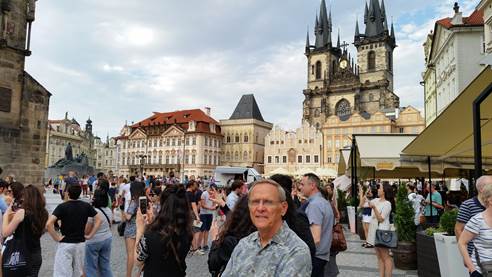
Jewish Quarter: This is a must-see section of Old Town although it is a somber reminder of the Nazi legacy. The “Jewish Museum” is a series of synagogues that have exhibits of the once-rich Jewish life of Prague. The most poignant is the Pinkas Synagogue where more than 77,000 names are hand-painted on the interior walls – listing the Jewish Czechs lost to the Holocaust. In the photos: Rita standing in one of the rooms of names and a close-up showing Arnost Korbel, Madeleine Albright’s father (line 9).
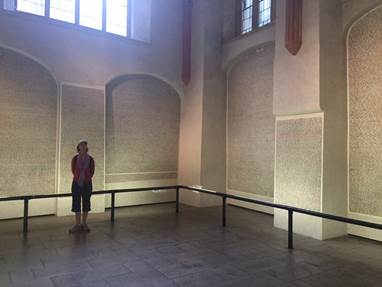
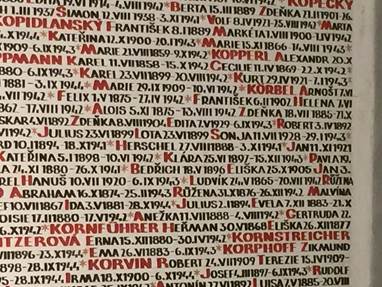
Lennon Brothers: When John Lennon died in 1980, this wall in the Little Quarter below the castle was filled with Lennon-inspired graffiti and lyrics from Beatles’ songs. The authorities repeatedly painted over the graffiti, but that attracted more graffiti and inspired this as a protest site. The student movement was described ironically as Lennonism. After the Velvet Revolution, the graffiti was allowed to stay, to the delight of Beatles’ fan Rita.
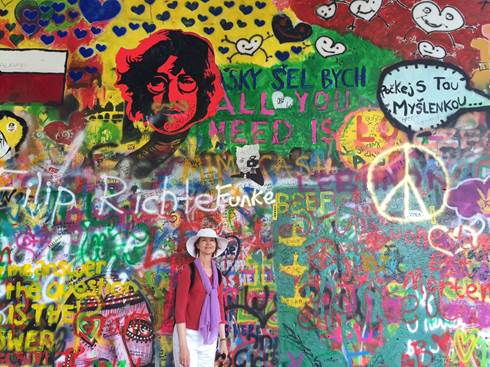
Another common sight before the Velvet Revolution were statues around town of various Communist figures such as Vladimir Lenin (Russian for Lennon?). The only place to see those statues now is in the Museum of Communism which shares an entrance with a casino and is located next door to capitalist icon McDonald’s.
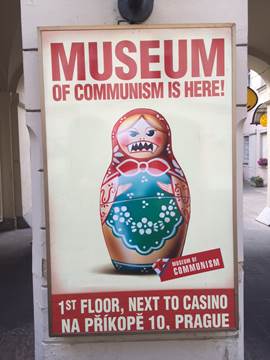
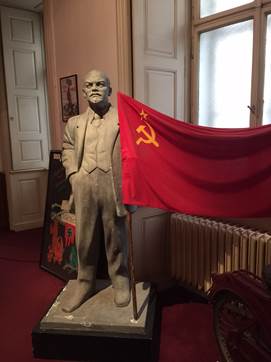
New Town: The area outside the historic district is called New Town and is centered on Wenceslas Square (that good Bohemian king who is now the patron saint of the Czech state). This is where the tanks rolled in for Prague Spring and where hundreds of thousands protested to force the Velvet Revolution. The art and architecture are more modern, especially as seen in the art of a founding father of Art Nouveau, Alfons Mucha, whose work can be seen in the excellent Mucha Museum and on the walls and ceiling of the Municipal House. Even more modern is the Dancing House designed by architect Frank Gehry who is best known for his Guggenheim Museum in Bilbao, Spain. The building is nicknamed Fred and Ginger (she has 10 legs, and Larry and Diana joined in).
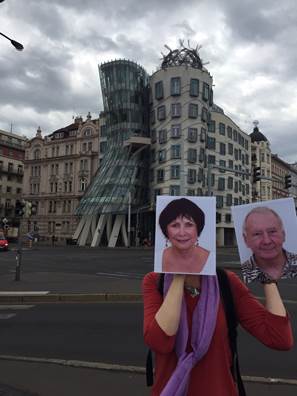
Budweiser: Larry is a beer aficionado and so is well aware that the Budweiser made in St. Louis is not the same as the one bottled in the Czech Republic. The two companies have been in court for decades over the use of the name. We thought Larry would enjoy a drink from the Czech version. The Czechs have the highest per capita beer consumption in the world – as the guides constantly reminded us.
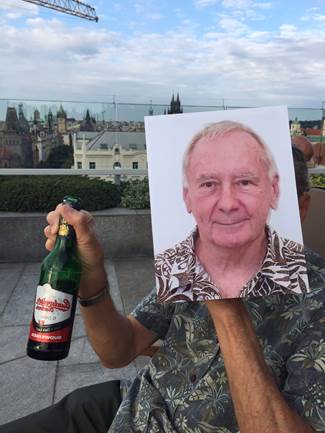
Starbucks: I like Starbucks and get a venti almost every day in KC. But I try to avoid that habit in foreign countries – preference is to drink local. Like McDonald’s, Starbucks is everywhere in Europe, but two stores caught our eye as clearly out of place. One was at the edge of a courtyard of Prague Castle. Thankfully, no big outdoor sign. Another was planted next to the Sacher Hotel in Vienna where the chocolate shop has been famously dishing out Sachertortes since the 19th century. Austrian coffee with that please.
The Cruise: The cruise was scheduled to start in Nuremburg, but the extended drought had lowered the water level too much for that stretch of the Danube. We started instead at Passau, Germany, where we boarded the Avalon “Impression” with about 150 passengers and showed Diana and Larry the stateroom.
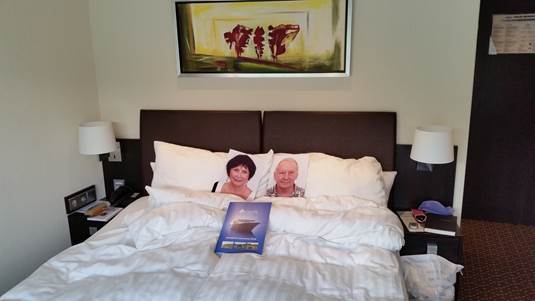
We bussed over to Regensburg for our first excursion and then sailed to Austria for stops in Linz, Melk and Vienna. After Vienna, we sailed through Slovakia (the other spouse in the Velvet Divorce) and finished in Budapest. The most scenic part of the cruise was Wachau , a 25-mile valley between Melk and Krems. And no, the Danube is not blue.
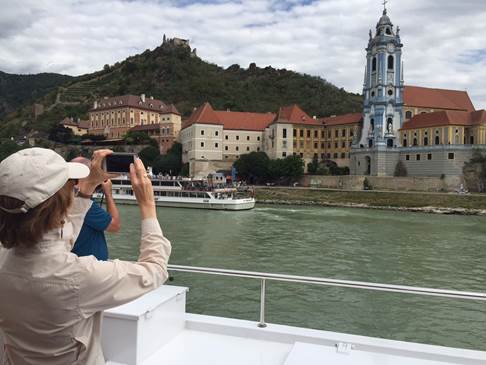
Cesky Krumlov: From our port stop in Linz, we took an excursion back over the border to the Czech Republic. Cesky Krumlov today is a tourist magnet with the look of a medieval theme park. Disney would be impressed. A nice place to visit, but the fairy tale look hides a rough 20th century. The city is part of the Sudetenland, a heavily Germanic area at the time Czechoslovakia was established at the end of WW1. This gave Hitler an excuse to annex the area in 1938 and expel the Czech minority. At the end of WW2, the tables were turned, and 3,000,000 Germans were forced to leave Czechoslovakia, many from families that had been there for centuries.
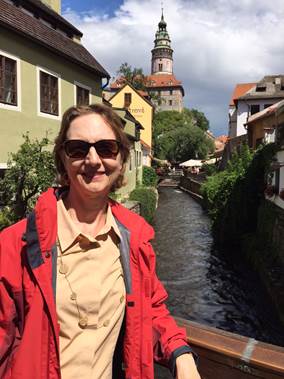

Melk: This stop features the impressive Melk Abbey, currently home to 30 Benedictine monks who oversee a multi-million dollar tourism business. Busloads of tourists come to see the church and library built in the 1700’s.
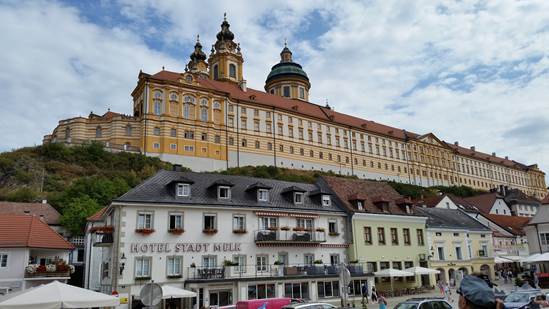
Shopping: By the time we had dress-up night on the cruise, Rita had purchased a dress in Prague and a hat in Passau (below, toasting with Diana and posing with her date); the new purse is not shown as it was not purchased until Vienna). Otherwise, very little time for shopping.
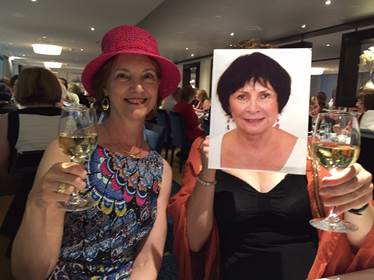
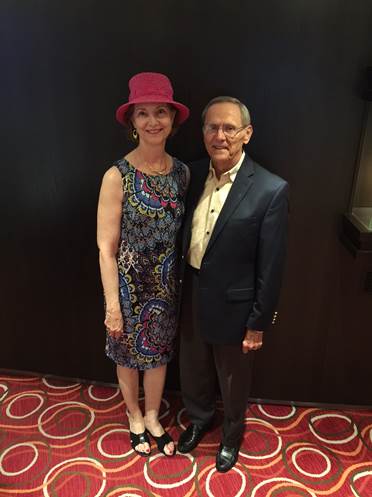
Vienna/Woman in Gold: We saw the movie “Woman in Gold” about the Gustav Klimt painting “Portrait of Adele Block-Bauer.” The painting was part of the loot taken from Jews by the Nazis, and after the war, the Austrian government hung the painting in the Belvedere Palace. Adele’s niece, an elderly Jewish refugee living in Los Angeles (Helen Mirren in the movie), fought for years to reclaim the family painting. She succeeded and sold it to the Neue Gallery in NY for $135,000,000. This history prompted us to seek out the Belvedere when we docked in Vienna – we wanted to see an even more famous Klimt: “The Kiss.” Alas, they do not allow photos of the original, but do conveniently provide a reproduction in the lobby. Faux Diana and Larry were able to enjoy the faux painting.
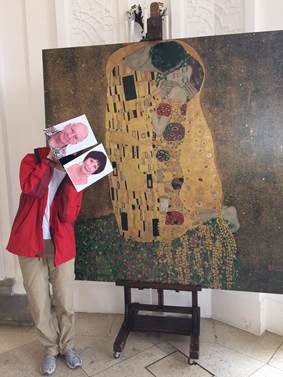
We were also on a mission to see two other paintings in Vienna: Vermeer’s “The Art of Painting” and “Summer” by Giuseppe Arcimboldo. The Vermeer because these are rare, and the other because it relates to a current exhibition at the Nelson. Both of these paintings are at the Kunst, Vienna’s fine arts museum completed in 1891 to house the Hapsburgs’ collection. Arcimboldo was a favorite in the court of Rudolf II and from 1563 to 1573 completed a series of paintings known as the “Four Seasons.” Until October 18, you can go to the south lawn of the Nelson and walk among four monumental sculptures inspired by these paintings.


The Kunst has large collections by several famous artists, but our bonus was that the museum interior is its own masterpiece. We had lunch in a café under the stunning dome and then admired other parts of the interior, lavishly decorated with work by local artists. One of those artists was a young Klimt who gave an early hint of what was to come in his paintings.
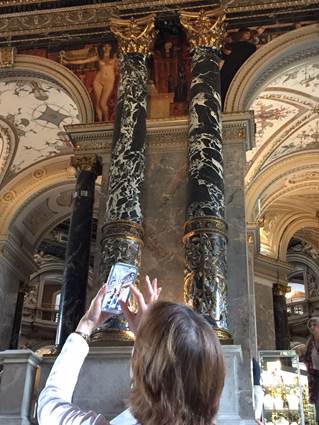

Budapest/Penguins: Our cruise ended in Budapest. We did not linger there because we had been there on earlier European trips. But if there are penguins, we cannot resist a photo.
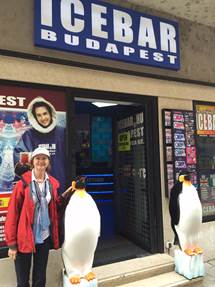
Leonard Cohen: While in Prague, I got an email from my secretary saying that a package had come in from LA. That meant that Rita’s vinyl album cover signed by Leonard Cohen had arrived. I won’t tell the long story, but we know Cohen’s manager and he agreed to arrange for Leonard to sign this 1967 debut album that Rita had purchased while in college. As many of you know, we are big fans and live by the words of his “Anthem” to “ring the bells” and recognize that there “is a crack in everything, that’s how the light gets in.” What does this have to do with our trip? Well, we got unexpected and pleasant reminders of Leonard during our cruise. In Regensburg, we were walking the square and heard a familiar song from a street musician. Leonard’s “Hallelujah” – in German. At a crew variety show on the ship after dinner one night, the sweet Hungarian receptionist sang the same song, but in English. Not done yet. In Vienna, we saw two street musicians who appeared to be conservatory students – she on the harp and he a tenor singing an operatic “Hallelujah” in English. Since Leonard wrote the song, it has been recorded by over 300 artists and is covered by a whole lot of lounge singers and street musicians around the world. Leonard Cohen – the gift that keeps on giving.
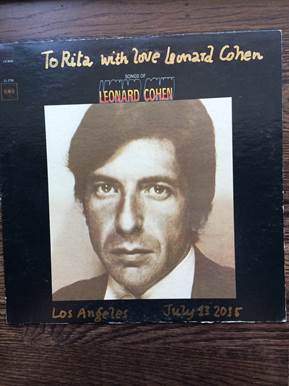
Parting Shots: Moonlight over Old Town Square and Prague Castle.
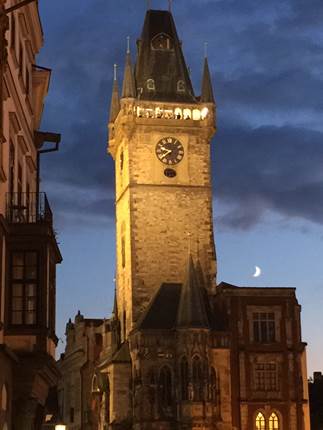

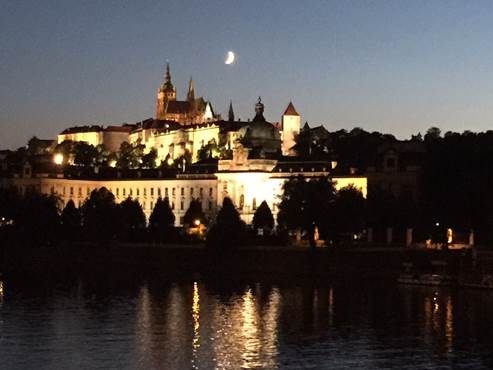
Photography Credits: Samsung Galaxy S5 (Rita) and Apple iPhone 6 Plus (Lonnie).
Music Credits: Leonard Cohen and k.d. Lang (click here for her “Hallelujah”).